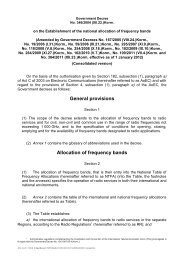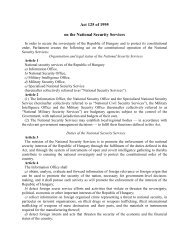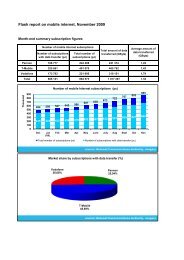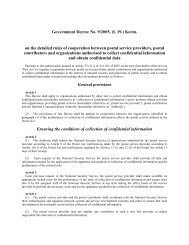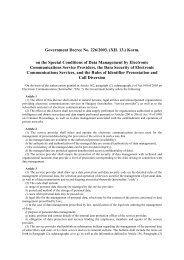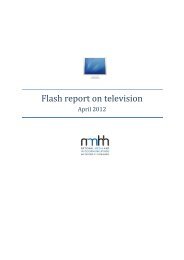The Hungarian Communications Market Developments and ...
The Hungarian Communications Market Developments and ...
The Hungarian Communications Market Developments and ...
You also want an ePaper? Increase the reach of your titles
YUMPU automatically turns print PDFs into web optimized ePapers that Google loves.
40 41<br />
Figure 3.18: Cable television penetration in the OECD countries<br />
%<br />
80<br />
2002<br />
2005<br />
60<br />
40<br />
20<br />
0<br />
Greece<br />
Italy<br />
New Zeal<strong>and</strong><br />
Turkey<br />
Spain<br />
Mexico<br />
United Kingdom<br />
France<br />
Czech Republic<br />
Australia<br />
Portugal<br />
Pol<strong>and</strong><br />
Icel<strong>and</strong><br />
Finl<strong>and</strong><br />
Austria<br />
Irel<strong>and</strong><br />
Slovak Republic<br />
Norway<br />
OECD<br />
Denmark<br />
Hungary<br />
Japan<br />
Sweden<br />
Germany<br />
United States<br />
Canada<br />
Korea<br />
Luxembourg<br />
(Wallonia)<br />
Switzerl<strong>and</strong><br />
Netherl<strong>and</strong>s<br />
Source: OECD <strong>Communications</strong> Outlook, 2007<br />
According to NHH’s service provider survey (data collected as part of a<br />
market surveillance procedure), cable television service was available for<br />
82 percent of <strong>Hungarian</strong> households in 2007 (homes passed). <strong>The</strong> index<br />
is continuously increasing as large development projects took place as<br />
regards the cable networks even in the past few years. Consequently, Internet<br />
service <strong>and</strong> voice-based (VoIP) service was also available in 74 <strong>and</strong><br />
31 percent of households covered by cable network, respectively. <strong>The</strong><br />
availability of the VoIP service means that the 3-play service is also available.<br />
<strong>The</strong> household penetration of Internet service <strong>and</strong> VoIP service provided<br />
through cable network was 10.5 <strong>and</strong> 3 percent, respectively. At the<br />
end of 2007, significant service providers, such as UPC <strong>and</strong> T-Kábel had<br />
123 thous<strong>and</strong> <strong>and</strong> 19 thous<strong>and</strong> 3-play subscribers, respectively. Moreover,<br />
digital cable television service (DVB-C) has also been launched.<br />
According to an NHH survey in June 2005, 19 service providers had,<br />
at least partially, digital networks with around 325 thous<strong>and</strong> subscribers.<br />
Nevertheless, at the end of 2006, already 26 service providers offered<br />
digital programme reception with digital cable networks reaching as many<br />
as 760 thous<strong>and</strong> households. In March 2008, the largest cable service<br />
provider also launched its digital cable television service in Budapest <strong>and</strong><br />
in four other big cities. During the first three months of the introduction of<br />
the service, 50 thous<strong>and</strong> UPC subscribers had their analogue servicepackages<br />
replaced by digital ones.<br />
On 31 December 2006, in the multi-player cable television service<br />
market 373 service providers provided cable television services. In spite<br />
of this, the <strong>Hungarian</strong> market is fairly concentrated, with five major service<br />
providers covering significant share of the households. <strong>The</strong>ir combined<br />
market share according to the number of subscribers was 68 percent<br />
in 2003, which has decreased to 61 percent by 2007. Locally, however,<br />
individual service providers do not really compete with each other in view<br />
of the fact that there are hardly any areas covered with parallel networks.<br />
<strong>The</strong> cable television market has seen a price increase in the previous<br />
years. As a result of the competition between platforms, this process has<br />
remarkably slowed down <strong>and</strong> even stopped by 2007. <strong>The</strong> entry of Digi<br />
Ltd. (Digi TV), a new digital satellite service provider with an aggressive<br />
strategy played a significant role in boosting competition.<br />
Figure 3.19: Average monthly spending on cable television<br />
HUF<br />
4 000<br />
3 000<br />
2 000<br />
1 000<br />
3239<br />
3618<br />
3738<br />
2004<br />
2616<br />
2005<br />
2006<br />
2007<br />
0<br />
Dec 2003 Jun 2005 Nov 2006 Dec 2007<br />
Source: NHH-TÁRKI-Ithaka, “Use of <strong>Communications</strong> Services”<br />
According to customer surveys, households with cable television<br />
paid about HUF 3,700 on average for this service at the end of<br />
2007, which shows a HUF 1,000 (43 percent) increase in comparison<br />
with 2003 figures. Apart from the increase in prices, higher monthly<br />
spending was attributable to the fact that subscribers have turned




